
Building a home recording studio is a HUGE project…isn’t it?
It takes months of planning, research, and preparation…doesn’t it?
Well most people think so at first, but it’s actually way easier than you’d imagine.
Because while the full list of studio equipment is quite long and complex...you really only need about 8-9 of those things to get started.
So in this post, I’ll show you exactly what they are, as I walk you step-by-step through the entire process of building a simple home recording studio from scratch.
Here’s what you’re about to discover:
- Why a Simple Home Recording Studio is Best (At First)
- Can a Home Recording Studio Be Too Cheap?
- The 9 Home Recording Studio Essentials
- A Computer…Ideally a Laptop
- A DAW/Audio Interface Combo
- A Few Essential Microphones for Your Main Instruments
- Closed-Back Headphones to Monitor Your Playing
- Studio Monitors to Hear Your Mixes
- XLR Cables to Connect All Your Gear
- A Stand for Your Microphones
- A Pop Filter for Recording Better Vocals
- Ear Training for Home Recording Studio Engineers
First up…
Why a Simple Home Recording Studio is Best (At First)
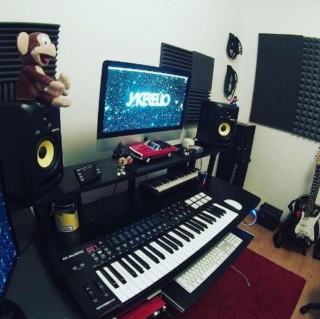
Not only is it possible to start off with just a simple studio…it’s actually preferable.
Because just like with any new hobby or skillset, by attempting too much too soon:
- you get overwhelmed,
- you get discouraged, and…
- you eventually quit.
So keep it simple, at least for now.
Can a Home Recording Studio Be Too Cheap?
As music can be an insanely expensive hobby, musicians are often accustomed to find the cheapest possible solutions to their problems.
Which is normally fine….but with home recording, there is such a thing as too cheap.
While it’s possible to build a working studio for as little as $400-$500…the limitations far outweigh the savings…so I don’t recommend it to anyone truly serious about recording their music.
Instead…here’s a setup that I do recommend:
The 9 Home Recording Studio Essentials
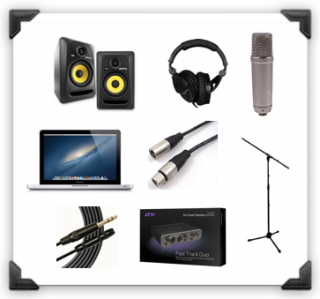
With the following 9 items:
- A Computer
- DAW/Audio Interface Combo
- Studio Monitors
- 1-2 Microphones
- Headphones
- A Few Cables
- One Mic Stand
- A Pop Filter
- Ear Training Software
…What you have is a simple, functional home recording studio, that allows you to get started ASAP with minimal investment in both time and money.
It will also give you plenty of flexibility to expand your studio in the future, piece by piece, as your skills and needs mature.
Now let’s look at each item on the list…
A Computer…Ideally a Laptop

When starting your first studio from scratch, the computer will be the biggest expenditure by far.
That’s assuming of course, you don’t already have one…
Which would be unusual, since these days…who doesn’t?
Over the last few decades of home recording studios, one of the biggest challenges was getting your hands on a computer that was fast enough for the job.
However in just these past two years, the computer speeds have become exponentially faster, and so even the most affordable laptops are good enough to get started.
So in the beginning, regardless of your budget, I recommend using what you have for now.
If and when you want to upgrade later on, here’s what I recommend:
Classic Example:
- Macbook Pro – (Amazon/Sweetwater)
Up next…
A DAW/Audio Interface Combo
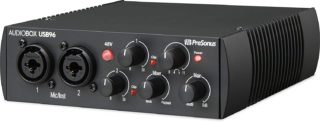
The Digital Audio Workstation (DAW) is the software used to:
- Record
- Edit
- Mix
…on your computer.
The audio interface is the hardware that your DAW uses to record sound from your mics/instruments, and send sound out through your headphones/monitors.
DAW’s and audio interfaces can be bought either as a pair, or separately.
But for your first studio…I highly recommend getting them as a pair. Since it’s cheaper than buying them separately, and you get guaranteed compatibility/tech support.
Plus, the companies that offer DAW/interface combos are among the best in the business.
Presonus offers a free copy of their Studio One Artist DAW with the following popular interfaces:
- PreSonus AudioBox GO (w/Studio One Prime) – (Amazon/Sweetwater/Thomann)
- PreSonus AudioBox USB 96 – (Amazon/Sweetwater/Thomann)
Steinberg offers a copy of their Cubase DAW with the following interfaces:
- Steinberg UR12 – (Amazon/Sweetwater/Thomann)
- Steinberg UR22C – (Amazon/Sweetwater/Thomann)
Of course, this only scratches the surface with possible interface/DAW combos you could choose from. So to learn about this subject in more depth, here are two separate articles I’d recommend checking out:
Up next on the shopping list…
A Few Essential Microphones for Your Main Instruments
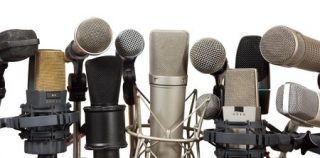
As your home recording studio matures over time…
You will eventually amass a collection of dozens of different microphones, each for their own specialized purposes.
For now though, all your really need is 1 or 2 to get started.
And the ones you choose will depend on the instruments you plan to record.
Since most people start out just recording vocals, the “classic” large diaphragm condenser vocal mic I recommend is the:
- Rode NT1 – (Amazon/Sweetwater/Thomann)
For instruments rich in high frequencies, such as acoustic guitar, piano, or cymbals…the small diaphragm condenser mic I recommend is the:
- AKG P170 – (Amazon/Sweetwater/Thomann)
For drums, percussion, and electric guitar amps, and other mid-frequency instruments, the best mic to start with is undoubtedly the:
- Shure SM57 – (Amazon/Sweetwater/Thomann)
On bass guitar, kick drums, and other low frequency instruments, a great mic to start with is the:
- AKG D112 – (Amazon/Sweetwater/Thomann)
If you want to get started ASAP, the 4 mics I’ve just shown you are perfect.
Yet as you’ll eventually discover, the topic of studio microphones still deserves far more discussion.
So I’ve dedicated an entire chapter of this website to just that. Here it is:
Up next…
Closed-Back Headphones to Monitor Your Playing

In a recording studio, there are 2 very specific headphone designs used for two purposes.
There’s Open-back headphones, which are sometimes used for mixing, and therefore designed primarily for optimal sound quality.
These are considered more of a luxury, and not at all necessary for your first studio.
Instead, closed-back headphones are what you’ll need.
These headphones allow musicians to hear both the backing track, and their own instrument, as they record their instruments.
These types of headphones prioritize sound isolation at the expense of lesser sound quality. Which makes sense, because their primary purpose is to avoid leakage from the headphones into the microphones.
The two best options for closed-back headphones are undoubtedly:
- Sennheiser HD280 Pro – (Amazon/Sweetwater/Thomann)
- Sony MDR 7506 – (Amazon/Sweetwater/Thomann)
As a supplement to your headphones, I also recommend an extension cable…since standard headphone cables are always too short.
A word of caution though: With THIS cable especially, I highly advise getting the best one you can afford, as cheaper ones have horrible signal problems from the constant movement.
Personally, I like this one: Mogami Headphone Extension 25′ – (Amazon/Sweetwater)
To learn more about studio headphones in general, check out this article:
Up next…
Studio Monitors to Hear Your Mixes
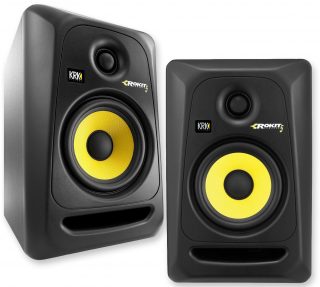
In the last section, we briefly touched on how some home recording studios use open-back headphones to do their mixing.
While this method does have its advantages (mainly silence)…
You ideally want to do the majority of your mixing on speakers, aka studio monitors, as that’s how it’s traditionally done.
Compared to consumer speakers, which are designed with various tonal “enhancements”, studio monitors have a much flatter frequency response, with a neutral, uncolored sound to objectively judge your mix.
While they can get pricey…there are still plenty of affordable options for beginners as well. Such as this one for example:
- KRK Rokit 5 G4 – (Amazon/Sweetwater/Thomann)
To see my full list of top studio monitors at various price ranges, check out this post:
Up next…
XLR Cables to Connect All Your Gear
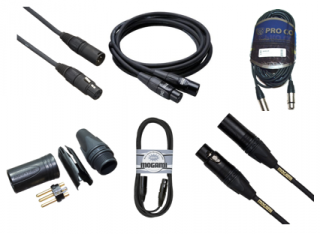
So now that you’ve got yourself a bunch of gear, you’re going to need some cables to connect them.
One day, your studio will have a TONS of different cables. But for now, you only need 3:
- 1 long XLR cable – to connect your mic to the audio interface
- 2 short XLR cables – to connect your audio interface to your studio monitors
For a standard project studio in a small 10×10 room, these are the EXACT ones I recommend:
- Mogami XLR 25ft (1x) (for your mic)
- Mogami XLR 6ft (2x) (for your monitors)
Before you buy them, double-check that the stereo output of your audio interface has XLR connectors.
Sometimes they use TRS, in which case, you’ll need these instead:
- Mogami TRS/XLRM 6ft (2x) – (Amazon/Sweetwater)
As you can see, good mic cables can get fairly expensive, and while there are a lot of cheaper options here, this is one part of your studio where you really want the best you can afford.
Cheap mic cables break quickly, and can be extremely vulnerable to noise from handling and radio interference.
To hear more on this topic, here’s another post:
Up next…
A Stand for Your Microphones
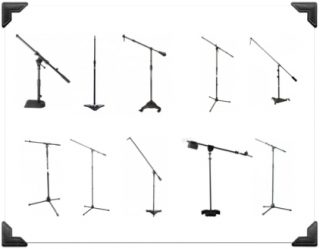
While you might imagine that all microphone stands are the same…
A really solid mic stand is one of the most worthwhile investments a new home studio can make.
However, since they can get pricey, and most beginners are on tight budgets…
A cheap reliable stand is more than adequate when you’re first starting out.
If I had to recommend one specifically, here’s a good mid-range option that you’ll definitely be impressed with:
- DR Pro Boom – (Amazon)
To see my complete list of recommendations, check out this post:
Up next…
A Pop Filter for Recording Better Vocals
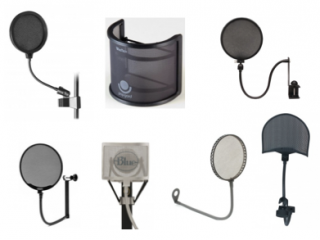
While you’ve surely seen pop filters used for recording vocals in movies and television…
Chances are, you’re not entirely sure what exactly they do. So here’s a quick explanation:
The purpose of pop filters is to filter-out an unpleasant vocal artifact known as popping...
Which is a low frequency blast of air caused by the pronunciation of “P” and “B” sounds.
While not really a must-have for a beginner’s home studio, they’re pretty cheap, and they do help.
And for some reason, many beginners still feel they must have one, so I’ve included it on this list anyway.
For a quick recommendation, here’s what I’d suggest:
- Stedman Proscreen XL – (Amazon/Sweetwater/Thomann)
Otherwise, if you’d like to learn more about this subject, check out this post:
Up next…
Ear Training for Home Recording Studio Engineers

On a typical list of home recording studio essentials, you might not even see ear training software at all.
Yet I’d argue that it’s quite possibly the most important long-term studio investment you can make.
Because more so than any piece of gear you might buy…the one thing that makes the biggest difference in the outcome of your recordings is your EARS.
And while you might believe your ears are pretty good already…
Having a good musician’s ear is not at all the same as having a good sound engineer’s ear.
As musicians, we learn to recognize notes, intervals, and chords. But as sound engineers, we learn to recognize bands of frequencies.
And until your ears develop a basic grasp of this skill, you won’t really know if things are sounding good or not.
Which is why I believe that if you start training your ears from DAY ONE, the speed at which you improve will skyrocket.
So here’s the software I’d recommend:
For more detail on this topic, check out this post:
By the way, if you found this post useful, I highly recommend joining our free Home Recording Secrets email newsletter where you’ll discover….
- How to Get Your First Studio Up and Running in a Single Weekend
- How to Avoid Wasting Thousands of Dollars on Unnecessary Pointless Purchases
- How to Get a “Million Dollar” Pro Studio Sound in a “Thousand Dollar” Home Studio
- PLUS… All Sorts of Other Amazing Insider Secrets Revealed
And it’s totally FREE! Click here and Enter Your Email to Sign Up.